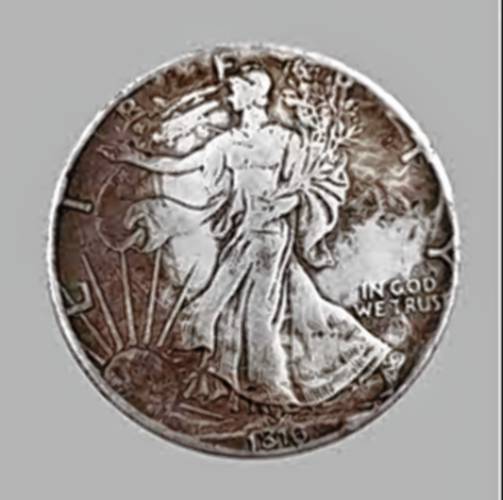Vintage Views: An apron full of silver dollars

Photograph Credit: James W. Spain. It is a fortune in 1816 Silver Dollars that remain lost in Barrington, New Hampshire. Courtesy—
| Published: 08-17-2024 6:00 AM |
Travel back with me 208 years to Barrington, New Hampshire. It is the Hayes family I greet, some of the earliest settlers of Barrington and known locally as hard-working farmers. The Hayes family resided over on Green Hill and grew their crops like many of the farmers during their day. If the crops were good the family was sustained for the winter, if the crops were bad the family suffered and died.
It was the year 1816 that delivered much hardship to many towns in New Hampshire, a cold miserable summer concluded by an early frost. The farmers were very concerned about the approaching winter for their already strained resources were now in a state of depletion with the winter of 1816 approaching quickly.
The low lands planted with corn captured the early killing frost, a late start due to frozen fields in May meant a late harvest. This harvest was interrupted in July with a frost with some ice on the corn again in July. The month of August brought rain and some scattered snow with the end of August delivering the killing frost that claimed the corn and potatoes the farmers depended upon.
The killing frost spread beyond Barrington and up to Alton as well as over to Dover. Mother Nature showed no mercy to the farmers back in 1816, the low land crops failed very quickly, but there was one fortunate farmer that always planted on top of the hill.
It was James Hayes in Barrington that was spared the wrath of the other unfortunate farmers, his ten acres of corn planted upon a hill survived and provided many pecks of corn. He in fact had quite an abundance of corn at harvest time, he harvested again and again and stored his many pecks in his barn for the winter months.
Word soon spread amongst the farmers in the area that James Hayes crops survived and he enjoyed a good harvest. It was soon that the people started to visit Mr. Hayes and inquire about his harvest as well as asking if he might have enough corn to share with the distraught farmers facing starvation over the pending winter.
James Hayes met with people that travelled far upon their horse drawn wagons in search of the opportunity to purchase a few pecks of corn. Hayes quickly realized that he did indeed have an opportunity that might not present itself again. James Hayes made it known to anyone that would listen that he did indeed have a wonderful crop as a result of his bountiful harvest.
In fact, he would share his good fortune with anyone in need for a price. The price and the only form of payment he sought and would accept was one silver dollar per peck of corn. So it was during the late summer and early fall of 1816 that people travelled for many miles to the farm on the southerly side of Green Hill in Barrington to purchase their pecks of corn.
Article continues after...
Yesterday's Most Read Articles
They were grateful for the opportunity to purchase this corn for it would help them support their families over the long New England winter of 1816. The people met with James, many people arrived and each and every visitor held a handful of silver dollars to purchase their pecks of corn.
It has been said the silver dollars were many, the family filled a large trunk with their new found wealth and even loaned some of their money to the Strafford Bank over in Dover. Most of the fortune remained on the farm in the solitary trunk under the watchful eyes of the Hayes family.
Mrs. Hayes lost her husband soon after their bountiful harvest of many silver dollars. She had serious concerns about her grandson and felt the fortune would be lost if she did not maintain control of the silver dollars. She devised a plan to protect her fortune, a plan that was both practical and logical.
It was late one evening when James Hayes widow filled her apron with silver dollars and walked into the deep forest near her farm. She dug a hole between three trees and deposited her silver dollars safely. She returned to her farm and continued to scoop the silver dollars into her apron time and again. When the trunk was empty she covered the silver dollars with soil one last time.
The years passed, Mrs. Hayes eventually passed away. Her children and grandchildren passed in time too. The Hayes family was never able to locate the exact spot where the hoard of silver dollars was buried and the three trees marking the location grew and reproduced more trees.
The forest thickened as the plot did too, many have travelled to Barrington over the past two hundred years in search of this lost treasure. As late as the year 1930 the legend still lived over in Barrington, but the lost treasure was never reported as being found.







 “A Universe of Rainbows”: Warner author releases children’s poetry anthology
“A Universe of Rainbows”: Warner author releases children’s poetry anthology  Comics in Concord: Old School Comic Show bringing hundreds to Everett Arena
Comics in Concord: Old School Comic Show bringing hundreds to Everett Arena Margaritas in Concord holding 40th anniversary bash
Margaritas in Concord holding 40th anniversary bash Evolution Expo bringing wellness to Concord this weekend
Evolution Expo bringing wellness to Concord this weekend
